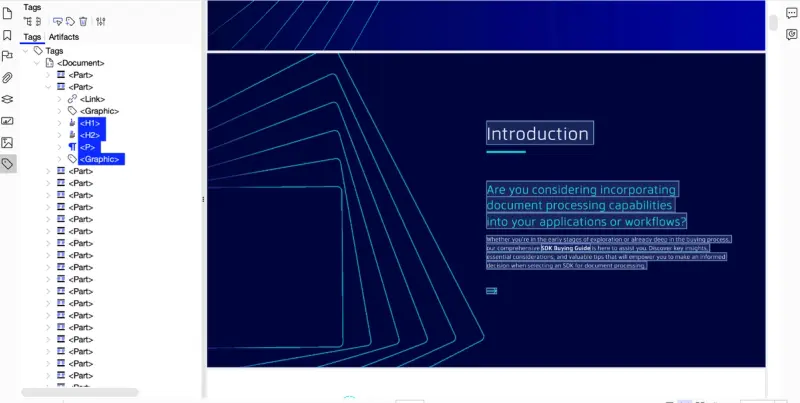Scaling Document Accessibility with Apryse’s Auto-tagging Solution
By Vimal Cherangattu | 2024 Oct 30

4 min
Tags
PDF accessibility
Summary: Apryse revolutionizes document accessibility with automated tagging. Simplify compliance, enhance inclusivity, and accelerate workflows for better user experiences.
Making digital content accessible is no longer just a regulatory requirement—it’s a critical business function that improves inclusivity and user experience. However, traditional methods of tagging documents for accessibility can be time-consuming, manual, and prone to errors.
Apryse’s new auto-tagging add-on for the Server SDK automates this. This update simplifies compliance with accessibility standards and speeds up workflows, ensuring businesses can deliver accessible content faster and more efficiently, all while leveraging the power of the Server SDK.
Why Auto tagging Matters for Document Accessibility
Tags in documents are crucial for making content accessible to all users, especially those relying on screen readers and other assistive technologies.
To ensure a document is accessible, certain elements must be tagged so they can be properly interpreted by assistive technologies, such as screen readers. Here are the key components that Auto-tagging by Apryse identifies and tags to create an accessible PDF:
- Headings and Subheadings:
- Headings are critical for organizing content and providing structure to a document. They allow users navigating with screen readers to understand the hierarchy of information.
- Lists:
- Ordered and unordered lists must be tagged correctly to convey their structure to users. Tags help identify list items and maintain the relationship between them.
- Tables:
- Tables require special tagging to define their structure, such as rows, columns, and headers. This ensures that users relying on assistive technologies can understand the data accurately.
- Images and Alt Text:
- Images need to be tagged with appropriate alternative text (alt text) that describes the content or purpose of the image, allowing users with visual impairments to understand what the image conveys.
- Links and Interactive Elements:
- Any hyperlinks, buttons, or interactive elements in the document should be tagged to ensure they are navigable and descriptive for users relying on screen readers.
- Paragraphs and Text Blocks:
- Text paragraphs should be tagged to help maintain the flow of information. Proper tagging ensures users can read the content in the intended sequence.
- Forms:
- Form fields need to be tagged properly to include labels and descriptions, enabling users to fill them out correctly with assistive tools.

Traditionally, applying these tags has been a labor-intensive process that involves generating reports, analyzing content, and manually adding the necessary tags.
With Auto-tagging by Apryse, businesses can automate this process. The feature intelligently scans documents, identifies necessary tags, and applies them automatically eliminating manual intervention and reducing the risk of errors.
Key Benefits of Apryse’s Auto-tagging Add-on
Automated Tagging Without Reformatting:
Apryse’s Auto-tagging automatically adds accessibility tags to documents without requiring any report generation or document reformatting. This means users can process documents faster while maintaining the integrity of the original format.
Increased Speed and Accuracy:
By automating the tagging process, businesses can significantly reduce the time spent on ensuring document accessibility. The Auto-tagging feature improves both speed and accuracy, ensuring compliance with accessibility standards without the need for extensive manual review.
Scalable for Large Document Workflows:
Whether you're working on a few documents or processing thousands, Apryse’s Auto-tagging solution scales effortlessly. This makes it ideal for organizations of all sizes that need to ensure accessibility across large volumes of content.
Feature | Manual Tagging | Apryse Auto-tagging |
|---|---|---|
Process Complexity | Involves manual analysis, report generation, and tagging, making it labor-intensive. | Automates the entire tagging process using AI, eliminating manual analysis and report generation. |
Time and Labor Costs | Requires significant human resources and time, leading to high labor costs. | Processes documents at scale quickly, reducing time and costs significantly. |
Accuracy and Consistency | Prone to human error and inconsistencies across documents. | AI-powered tagging ensures high accuracy and consistency, even for complex documents. |
Scalability | Difficult to scale; scaling requires more manpower, increasing costs. | Built to handle high volumes efficiently, making it ideal for enterprise use. |
Compliance Assurance | Requires oversight to ensure accessibility standards are met, with a risk of errors. | Automates compliance with accessibility standards, reducing the likelihood of missed requirements. |
Document Integrity | May require reformatting, which can compromise document layout and structure. | Maintains the original structure and layout of documents without reformatting. |
Use Cases for Auto tagging
Educational Institutions:
Schools and universities that provide digital content to students need to ensure that their materials are accessible to all learners, including those with disabilities. Apryse’s auto-tagging helps institutions automate the process of making course materials compliant with accessibility standards, ensuring an inclusive learning environment.
Corporate Communications:
Large organizations must ensure that their internal and external documents are accessible to employees and customers with disabilities. Apryse’s auto-tagging enables businesses to quickly tag everything from HR documents to customer-facing reports, reducing manual labor and compliance risks.
Legal and Government Documents:
Government agencies and legal entities often need to make official documents accessible. Apryse’s auto-tagging solution ensures that legal filings, public notices, and government communications are accessible to all citizens, improving compliance and inclusivity.
How Apryse’s Auto-tagging Enhances Document Accessibility
One of the standout features of Apryse’s auto-tagging solution is its ability to tag documents automatically without requiring document reformatting or manual review. This not only speeds up the process but ensures that users maintain full control over their documents.
With Apryse’s commitment to accessibility, auto-tagging integrates into existing workflows, reducing friction, and allowing organizations to achieve compliance effortlessly. It also aligns with accessibility standards such as WCAG 2.2 and PDF/UA, making it a reliable solution for businesses focused on inclusivity.
Apryse’s auto-tagging feature brings a revolutionary change to document accessibility by automating the tagging process. With increased speed, accuracy, and seamless integration into existing workflows, businesses can now ensure compliance with accessibility standards without heavy lifting.
Make your documents accessible today with Apryse’s auto-tagging solution and transform the way you handle accessibility in your organization. Contact us to learn more about how Apryse can simplify your document accessibility efforts.
Tags
PDF accessibility

Vimal Cherangattu
Share this post


